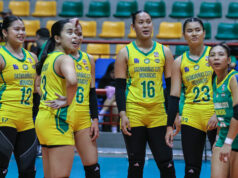Croatia Grand Chess Tour
Zagreb, Croatia
June 26-July 8, 2019
Final Standings
1. Magnus Carlsen NOR 2875, 8.0/11
2. Wesley So USA 2754, 7.0/11
3-4. Levon Aronian ARM 2752, Fabiano Caruana USA 2819, 6.0/11
5-7. Anish Giri NED 2779, Ding Liren CHN 2805, Ian Nepomniachtchi RUS 2775, 5.5/11
8. Sergey Karjakin RUS 2748, 5.0/11
9-11. Viswanathan Anand IND 2767, Shakhriyar Mamedyarov AZE 2774, Maxime Vachier-Lagrave FRA 2779, 4.5/11
12. Hikaru Nakamura USA 2754, 4.0/11
Average Rating 2782 Category 22
Time Control: 130 minutes play-to-finish with 30 second delay before the clock starts on every move
Last Thursday we talked about World Champion Magnus Carlsen’s wonderful performance in the Croatia leg of the Grand Chess Tour. Second-placer Wesley So did quite well himself.
He had three wins (against Ding Liren, Shakhriyar Mamedyarov and Hikaru Nakamura) and eight draws with no losses.
Second place in Zagreb was financially rewarding. Prize money was not peanuts: $60,000, roughly P3.12 million. This, combined with his $15,000 for 4th place in the Ivory Coast leg, means that he has earned $75,000 (around P3.9 million) so far from the Grand Chess Tour. And he still has two Rapid/Blitz events and one Classical tournament to go, to say nothing of the London Chess Classic in December should he qualify. Life is looking good.
In terms of rating points the result was worth an additional 18.7 ELO rating points. Last March 2017 Wesley So was ranked no. 2 in the world with an ELO of 2822. This also made him the fifth highest rated player in chess history. After his below-par performance though in last year’s Berlin Candidates’ Tournament where he lost three of his first seven games Wesley’s rating and world rank has been steadily going down. In the June 2019 list for example he was already down to 14th place overall. After Zagreb he had a big rating boost and is no. 4th overall with ELO 2781.7, behind Magnus Carlsen (2881.7), Fabiano Caruana (2817.8), and Ding Liren (2808.2).
While talking to GM Maurice Ashley after the game Wesley expressed his happiness for having finished in second place:
“Obviously the way Magnus is playing in recent months we don’t want to break his streak of winning all tournaments this year, so we just let him win it! But it feels like second place is already a victory whenever he’s playing right now, because it’s like Bobby Fischer, back in the 70s or 60s — when he was playing the US Championship and others are just playing for second place.”
Compatriot Fabiano Caruana had this to say about Wesley:
“He did great. He played well throughout and he was very consistent. The games that he won were excellent quality. Against Mamedyarov was an excellent game, also the game he won against Hikaru, besides some minor slip in the endgame seemed like an excellent game as well, so he played very well throughout, and maybe with a bit more luck could have fought for first.”
What was the slip he was talking about? Well, let us see.
So, Wesley (2754) — Nakamura, Hikaru (2754) [C67]
GCT Zagreb 2019 Zagreb (8.2), 04.07.2019
GM Alireza Firouzja: The way he (Wesley) outplayed Nakamura in a Berlin typically known as a boring draw was impressive.
1.e4 e5 2.Nf3 Nc6 3.Bb5 Nf6 4.0–0 Nxe4 5.Re1
The usual continuation here is 5.d4 Nd6 6.Bxc6 dxc6 7.dxe5 Nf5 8.Qxd8+ Kxd8, the so-called “Berlin Wall.” The position after the text move might look familiar to the BW reader, because I had just written about it in a 2–part series last June 4 and 6 entitled “Attacking the Berlin”! I will point out where the deviation is in the coming notes.
5…Nd6 6.Nxe5
Of course Black can’t play 6…Nxb5 because of 7.Nxc6+
6…Be7
The game we took up last June 6th continued 6…Nxe5 7.Rxe5+ Be7 8.Bd3 0–0 9.Nc3 Bf6 10.Re3 g6 (10…b6 11.Bxh7+ Kxh7 12.Qh5+ Kg8 13.Rh3 etc) 11.Qf3! Bg7 12.b3 Ne8 13.Ba3 d6 14.Rae1 Nf6 15.h3 Nd7 16.Nd5! f5 17.Nxc7! Qxc7 18.Qd5+ Kh8 19.Re8 Nf6 20.Rxf8+ Bxf8 21.Bb2 Bg7 22.Bc4 Bd7 23.Bxf6 Bxf6 24.Qf7 Qd8 25.Re8+! Black resigns. This is Nezhmetdinov, R — Kotkov, Y Russian ch 1957.
7.Bf1 Nf5
Wesley and Nakamura had gotten this position before, but Nakamura continued here 7…Nxe5 8.Rxe5 0–0 9.d4 Bf6 10.Re1 Re8 11.Rxe8+ Nxe8 12.d5 b6 13.Nd2 Bb7 14.Ne4 Be7 15.c3 Nd6 16.Ng3 Bg5 17.c4 Rc8 18.b3 Qf6 19.Bxg5 Qxg5 20.Qd4 Re8 21.Rd1 Nf5 22.Nxf5 Qxf5 23.Bd3 Qe5 agreed drawn. So, W (2765)-Nakamura, H (2746) Kolkata 2018.
8.Nf3 d5 9.d4 0–0 10.Nc3 Nh4 11.Nxh4 Bxh4 12.Bb5
Previously played here are 12.Bf4, 12.Be3 and 12.Ne2. This is a new move but clearly not a game changer. Surprisingly though Nakamura started taking his time between moves while Wesley was blitzing out his replies.
12…Ne7 13.Bd3 Bf6 14.Qh5 g6 15.Qf3 Bg7 16.Bg5 f6 17.Bd2 c6 18.Ne2 Nf5 19.g3 Nh6 20.c4 Bg4 21.Qg2
White is threatening to pile up pressure against d5 with 22.cxd5 Qxd5 23.Qxd5+ cxd5 24.Nf4 Rad8 25.Rac1 and 26.Rc5. Black has to watch out also for exchanges on d5 followed by Bc4.
21…dxc4 22.Bxc4+ Kh8 23.d5 Nf7 24.Nf4 Ne5 25.Be2 Bd7 26.Rad1 cxd5 27.Bc3 Bc6 28.Nxd5 f5 29.f4 Nd7 30.Bxg7+ Kxg7 31.Bf3 Nf6 32.Nxf6 Qxf6 33.Bxc6 bxc6 34.Rd7+ Rf7 35.Qd2
Threatening to win the black queen with Rd6.
35…Rxd7 36.Qxd7+ Kf8
Some commentators pointed out that 36…Kh6! would have been a tougher nut to crack, but that is counter-intuitive as it looks very dangerous to tuck the king in the edge of the board.
37.Re5!
The obvious move 37.Re6 would allow 37…Qxb2 with various threats of perpetual check.
37…Rd8 38.Qxh7 Re8 39.Qh6+ Kf7 40.Qh7+ Kf8 41.Qc7! Rxe5 42.Qxe5!
[42.fxe5?! Qe7 holds]
42…Qxe5
This is really an impressive demonstration by Wesley of endgame mastery. He allows the queen exchange and the Black king to capture his e5–pawn, but he sees (either through calculation or intuition) that he will triumph in the K+P ending.
43.fxe5 Kf7 44.h4 Ke6 45.Kf2 Kxe5 46.Kf3?
Wesley had seen that after the most logical move 46.Ke3 Black plays 46…c5 and now 47.Kf3 wins:
In a straight race Black is clearly lost: 47…Kd4 48.Kf4 Kd3 49.Kg5 Kc2 50.Kxg6 Kxb2 51.h5 it is significant that the king is now on b2, because once white’s pawn queens it will be with check. 51…c4 52.h6 c3 53.h7 c2 54.h8Q+ White wins easily; so
47…a5 48.a4 c4 looks dangerous, but White wins just the same: 49.Ke3 Kd5 50.Kf4 Kd4 51.Kg5 Kd3 52.Kxg6 Kc2 53.h5 Kxb2 54.h6 c3 55.h7 c2 56.h8Q+ once again an easy win.
Having seen all of that the devil came into his head: so why doesn’t he play his king to f3 right away and save a tempo? Turns out it is not that simple.
46…c5
No choice as once again in a straight race Black loses: 46…Kd4 47.Kf4 Kd3 48.Kg5 Kc2 49.Kxg6 Kxb2 50.h5 c5 51.h6 c4 52.h7 c3 53.h8Q and this time Black is even worse than in the previous variation. There at least Black’s pawn was on c2, just one square from queening.
47.b3! Ke6?
This is where Nakamura slips up. 47…a6! draws. Let’s see … 48.Ke3 a5 49.Kf3 Kd4 50.Kf4 a4! 51.Kg5 Kc3 52.Kxg6 axb3 53.axb3 Kxb3 54.h5 c4 55.h6 c3 56.h7 c2 57.h8Q Black king is on b3 instead of b2, this time no check. 57…c1Q the position is equal.
48.Kf4 Kf6 49.a3 a6 50.b4!
I think this is what Nakamura overlooked. Otherwise 50.a4 a5 is a draw. Neither king can enter into the other’s side of the board. For example, after 51.g4 fxg4 52.Kxg4 Kf7! 53.Kg5 Kg7 54.Kf4 Kf6 55.Ke4 Ke6 etc.
50…c4 51.a4 Ke6 <D>
POSITION AFTER 51…KE6
52.Ke3!
According to the “Chess24” website, from the body language of the players, it was only after this move that Nakamura realized he was lost.
52…Kd5 53.Kd2! Kd4 54.Kc2! c3 55.b5 1–0
Let’s just continue White’s idea: 55.b5 axb5 (of course not 55…Kc5 56.bxa6 Kb6 57.Kxc3 Kxa6 58.Kd4) 56.axb5 Kc5 57.Kxc3 Kxb5 58.Kd4 Kc6 59.Ke5 Kd7 60.Kf6 there is no more doubt. You know, playing over a game like this fills me with sadness, for I know I can never play this well.
As usual there are those detractors of Wesley who point to his 8 draws and complain that he did not fight hard to win every game. In answer to this let me paraphrase Vishay Anand back from many years ago in a similar situation when the Spanish press grumbled about his 5 straight draws at the start of a big tournament. A certain journalist even went so far as to suggest that Vishay was treating the tournament like a vacation. The response? It goes something like this: why don’t you go play Magnus Carlsen, Levon Aronian, Fabiano Caruana, Anish Giri and Sergey Karjakin, and see if you can get five draws.
Bobby Ang is a founding member of the National Chess Federation of the Philippines (NCFP) and its first Executive Director. A Certified Public Accountant (CPA), he taught accounting in the University of Santo Tomas (UST) for 25 years and is currently Chief Audit Executive of the Equicom Group of Companies.



